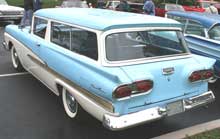Station wagons are as old as the hills. Billy Durant’s Star was the first to introduce one, and Ford the first to mass produce them, starting with the Model A. But until after World War II, with a very few exceptions like Bantam, all station wagons had four doors.
Credit Willys with two significant innovations in one vehicle: the two-door, all-steel station wagon of 1946. Crosley did too, starting in 1947, but it took the 1949 Plymouth Suburban to take the concept big time.
Ford Motor Company wasn’t ready for all-steel, but they did switch over to two-door wagons in 1949, both Ford and Mercury. FoMoCo’s steel shift came in 1952, but there was still a two-door, the Ranch Wagon, which endured through the fifties right up to 1960.
Plymouth, having pioneered the two-door wagon for the Big Three, kept it in the catalog until 1961, while Dodge didn’t have one until 1953 and kept it only to 1958 (nearly the same as this ’57). Chevrolet’s first debuted in 1955, and with it the glamorous Nomad, which led to a bevy of two doors, in 150, 210 and Bel Air trim. By 1956, Ford had its own Nomad fighter, the Fairline-trimmed Parklane and Plymouth, too, had fancier two-doors. Pontiac went the Chevy route with ’55 two-doors, but gave it up after 1957, having had their own Nomad lookalike, the Safari, for three seasons. Chevy’s last full-size two-door came in 1960, but after a three year hiatus there came a two-door wagon in the Chevelle line, through 1965 only. The same was true for Ford’s Falcon, which had two doors from intro in 1960 until 1965.
Mercury abandoned two-door wagons in 1952, but came back with a hardtop two-door for 1957, in both Commuter and Voyager trim. Both hardtop and two-door wagons lasted only through 1959.
Nash had a two-door wagon in the Rambler line through 1955, then brought it back as the Rambler American in 1959. The last Rambler two-door wagon was the 1963 American model. Studebaker’s first postwar wagon was a two-door, the 1954 Conestoga. The style lasted through 1956, after which it handed over to four-doors until the coming of the 1959 Lark, which reverted to two-doors only. The last two-door Studie wagon came in 1961. For whatever reasons, Chrysler, DeSoto, Lincoln, Cadillac, Buick, Oldsmobile and Packard never attempted a two-door wagon, and Hudson’s only postwar wagons were rebadged versions of the 1955 Rambler (Note this brochure illustration has no branding whatsoever, save for “R” on the wheelcovers).
So who kept the two-door wagon going the longest? Look back to that pioneer, Willys, who had a two door version of the Wagoneer in 1963 and kept it in production until 1968, then reincarnated it in 1974 as the Jeep Cherokee right up into the 1980s. By that time, though, Jeep was part of the sport utility movement that absorbed first the two-door wagons and eventually nearly all station wagons. Considering strictly “civilian” models, it looks like the 1965 Chevelle and Falcon were the last true American two-door station wagons. Have we missed any? And why do you think the two-door wagon took so long to emerge in the United States, and why did it fade in barely two decades? Tell us what you think.

